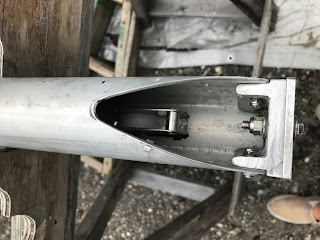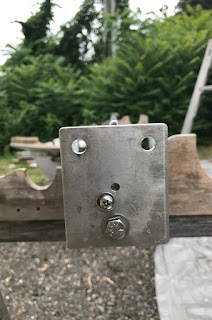Thanks to Tim Allen of Home Improvement for reminding us that in many cases, more power is the best solution!
Diana has, in fact, three sources of gaining 12-volt power; and all of them are independent and yet sort of interconnected.
Outboard motor 'trickle' system
The first is, of course, what passes for an alternator on the 9.9-HP outboard. Having electric start, there is a small regulated-power supply under the flywheel that will (really just attempt to) replenish the starting battery from what it took to start the motor. This works best perhaps with a small motorcycle/jetski-type battery; and it's especially helpful to be able to plug it into a dockside charger at the end of the day - all this assuming that any boat with a 9.9-HP outboard is essentially daysailed and kept on a trailer. This 'trickle' charger is worth maybe 1 or 1-1/2 amps - essentially nothing helpful.
Diana, however, is more akin to a proper yacht - she goes into the
water and stays there with no fixed date for hauling out (certainly not
every day! - probably not once a year actually). So the engine-start
battery is a standard 'house' type, a 24-series deep-cycle SeaHawk with
75 a/h, just like the other two aboard which are connected together as
the house bank.
Shore-power charger
Both these banks are connected to the onboard ProSport charger, which is a 'smart' type - it determines which of the banks needs more charge and apportions its 12 amps between the batteries, altering this ratio as the charging cycle proceeds. Whenever Diana is moored at a dock with 115-VAC power, she gets plugged in for this charger to do what it does.
Fuse & connection block above the charger
This is what you find upon opening the trap under the quarter berth. The yellow ProSport 12 charger is visible to lower left. This is mounted on (wood) standoffs about 7/8" away from the inside of the bulkhead, in front of an exhaust-heat opening of almost the same area as the heat sink.
The two fuses shown in the pic are for the
onboard (ProSport) charger's output (15a); the other one is for the
115VAC cooling fan directly under this (silver-painted elbow is just
visible below). The fan energizes with the same breaker as switches on
the charger. This is to satisfy a need for cooling as I installed the
charger in direct (deliberate) defiance of ProMariner's admonitions,
first of which is to install it in only a well-ventilated space.
The
other two of ProMariner's rules were to not cut either the 115VAC leads
from the power source and the line leads connecting the battery charger
and the battery, both of which I broke immediately, to discover that
the manufacturer's wire standards were woefully inadequate compared to
mine (minimum 14-ga AWG for motors, incandescent bulbs, or anytthing that gets warm or that can overheat). I mean they had like 20ga wire on the 115VAC power leads. What's up with that?
The connection block is for the bilge pump wiring.
The two wires entering from the left are for the two modes coming
down from the standard bilge-pump Auto/Manual selector. The three wires
to the right are those going to the bilge-pump terminals. So many
leave these connections in the bilge itself, which is just awful. This plan does not rely on Y-connectors or other dodgy wiring and, as on
Diana, there are no connections below these except the negative post
(for earth connections to bilge pumps) just beneath the surface of the
quarter berth (visible at very bottom of pic).
Bilge-pump wiring schematic
For your perusal, my
solution to bilge-pump wiring when both Auto/Manual selector and
remote-mounted terminal block (to keep all connections out of the bilge)
are present.
PVA charger
The other source of power is the 'solar system' - a 200-watt (16-amp) photovoltaic array (solar panel) mounted on the rack above the cockpit. Due to a marketing failure by Teleflex/Sierra, who discontinued the RotoSwitch SPDT On/On switch I needed (like the ones I already have for the running lights and the cabin lights), the PVA system ended up getting wired to only the house bank, leaving the starting battery out in the cold till we can plug in to a dock. This will probably get amended later, as soon as I can find a replacement for the RotoSwitch. At that point, since the PVA charge controller is not able to split the available charging current between two otherwise independent banks, it will have to be switched from one to the other and back again as needed.
PVA charge controller
This is the control system for the photovoltaic array (solar panel).
Top: 2a fuse for ammeter.
Middle, L to R: ammeter for PVA output; on/off switch, necessary for disconnecting PVA from onboard wiring such as for maintenance - since a solar panel is never 'off' if the sun is out; 20a circuit breaker for PVA output (protects all the rest in the event of an overcharge); head of screw holding shunt for the ammeter.
Bottom: 30a solar-panel charge controller from Blue Sky Energy; runs directly off the PVA (so is essentially invisible at night!); 20a circuit breaker (protects house bank and panel in the event of controller regulator failure).
Beside, in the white panel (port, outboard) is the 115VAC panel. The double breaker is the master (30a; but nothing more than about 12-15 amps is hooked up to this and Diana's shore cord is 15 amps). Almost out of view, below the master, is the sub-breaker for the onboard (ProSport) charger. Also wired to this is the cooling fan for the charger under the quarter berth.
A corner of the 12VDC panel is just visible farther forward (at lower right).
The bundle of wires going up to the panel above the quarter berth will get bound in black plastic loom - actually looks pretty cool, filling in for trim along the top of the teak bulkhead.
Top of house battery
One 'must' with me was for using the excellent Blue Sea Systems fuse-terminal block that mounts directly to the battery post. This satisfies, elegantly, the requirement by ABYC and most insurance companies including BoatUS for a fuse mounted within 7" of the battery positive terminal - before anything else gets hooked up. In the event of overcharged batteries (such as due to charger regulator failure, battery failure, or excessive electrical demand by a user) this fuse disconnects the battery from the accessories (the panel) and, most importantly, the whole wiring network. Without this, any unprotected wire could heat up, melt off its casing, and short/arc to something else... and then you've got a really neat little catastrophe.
(Those stupid terminal blocks that mount directly to the battery post should be flat-out prohibited. Only day fishermen in tinnies - who, statistically, are among the least seamanlike of all boaters - can get away with those; and they're welcome to them.)
There are two house batteries, one located under the after corner of each settee berth, for weight distribution. They're not wired together directly but both to the same post of the Blue Sea 5000-series on/off switch, to facilitate removing one at a time from the network. Each house battery is fitted with one of these fuse blocks, including a 30a fuse is the smallest-capacity fuse offered for these fuse blocks; but the panel happens to total just about 30a - that's with every single thing turned on, including a maximum load plugged into the 15a cigar-lighter-socket circuit - so, in the event one of the two batteries is taken out of the network, even under a full load the 30a fuse should be adequate.
The output wires from both the PVA controller and the ProSport charger are connected to the same post on the switch with the batteries - this serves as direct connection to the batteries (which are on opposites of the boat). At the 'On' post of the switch is a 30a breaker to protect the panel and wiring network.
In the case of Diana, the battery boxes
being built in under the settee berths incurred a height-clearance
problem - the Blue Sea fuse-block terminals would not fit under the
(plywood) lid. My solution was to fabricate, from copper bar stock, an
extension featuring a 90-degree twist and to mount the fuse block on its
side.
The pic does not show the vent tube at the after end (left in the pic) of the battery box - this is to convey the hydrogen 'gas-off' out of the accommodation and back to a snorkel under the cockpit (remember: hydrogen rises; and the snorkel's height keeps water from getting in - which would flow straight onto the top of the battery). The under-cockpit area is ventilated by a small solar-power exhaust vent in the Dorade box, which should, without sparks, carry this off without hassle.
My dad would certainly hate all this electrical complexity. He once claimed, 'I'd have been happy with an extension cord thrown through a window!' (a notion which inspired me to wire the three 115VAC domestic-type outlets using the body of an actual 14/3 contractor/exterior-grade extension cord! - all connections sealed with tinned-copper heat-shrink terminals of course). His Thoreau-like sense of simplicity can be stated, rather as that of Colin Chapman (Lotus Cars Ltd), as
Complexity + Expense + Weight = NOT SAILING.
But as I often remind him these days, Diana is not only a nicely-performing boat but a liveaboard home and working studio. Unlike my dad, I like being on the boat for extended periods and would rather be on the boat under way than at any marina or mooring. So for me the electrical system is rather mandatory. Luckily I enjoy planning and assembling it.
- JC2



































